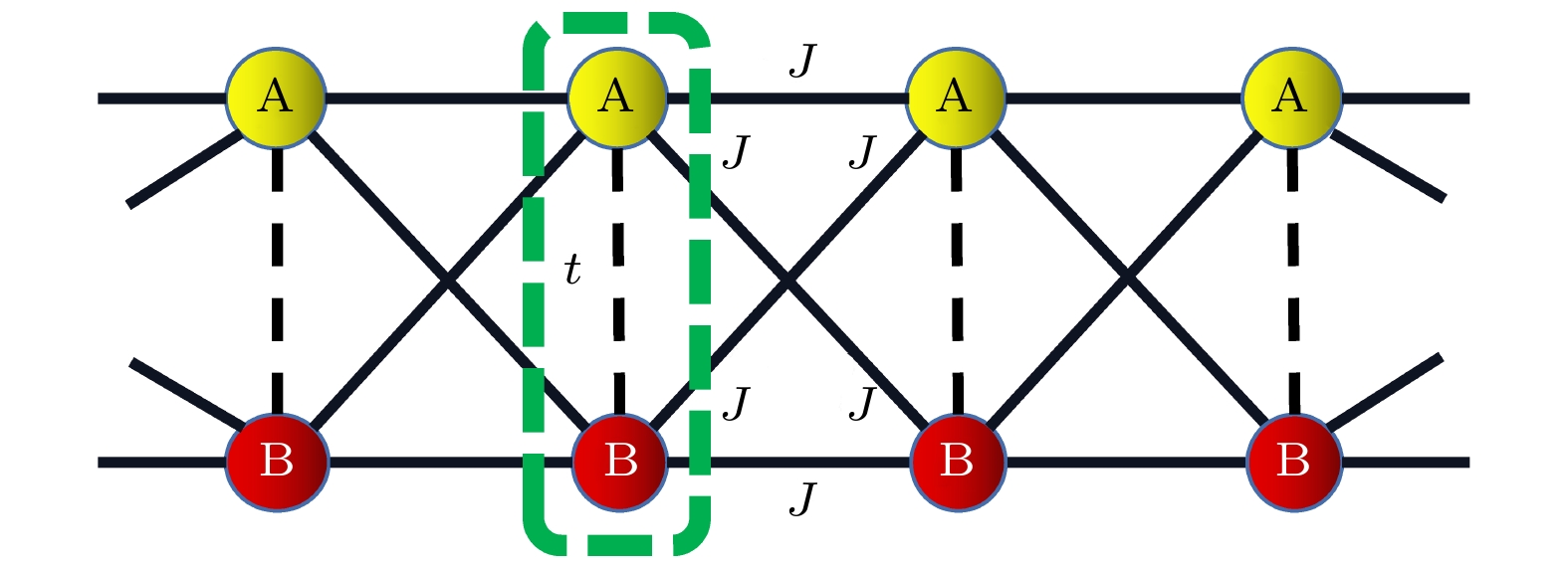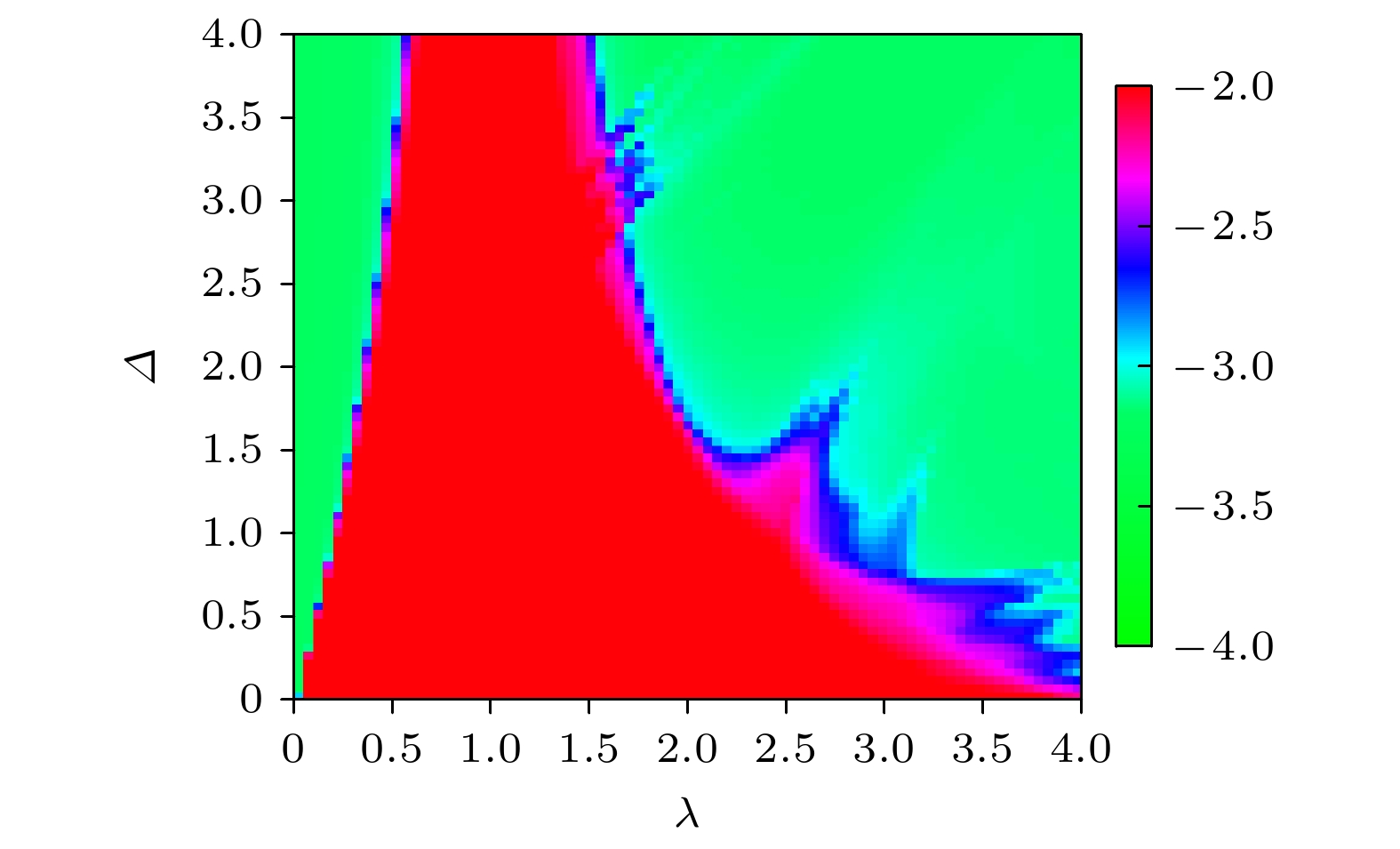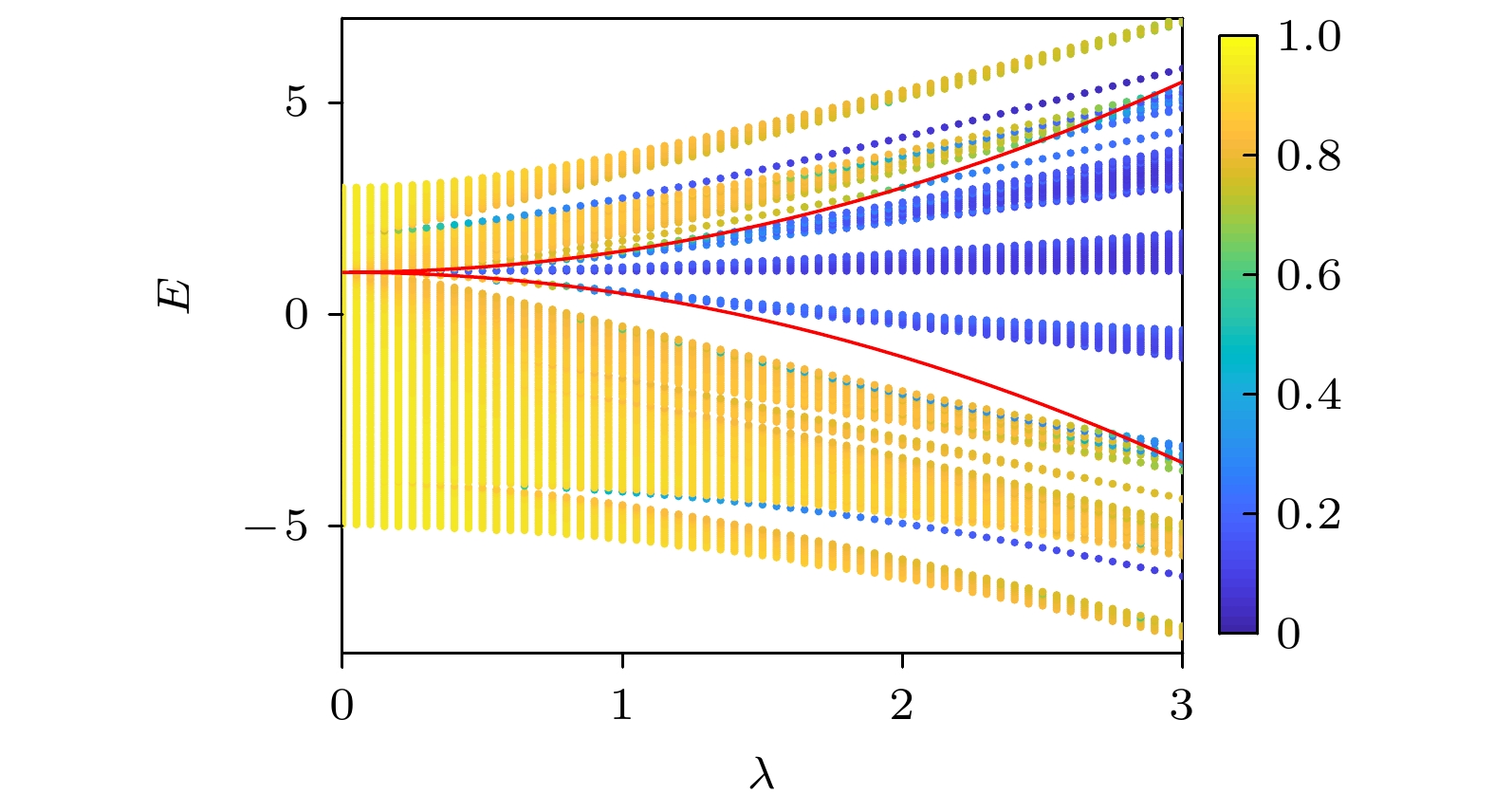-
In this work, we numerically study the localization properties in a quasi-periodically modulated one-dimensional cross-stitch lattice with a flat band. When
$\varDelta\neq0$ , it is found that there are two different quasi-periodic modulation frequencies in the system after the local transformation, and the competing modulation by two frequencies may lead to the reentrant localization transition in the system. By numerically solving the fractal dimension, the average inverse participation ratio, and the average normalized participation ratio, we confirm that the system can undergo twice localization transitions. It means that the system first becomes localized as the disorder increases, at some critical points, some of the localized states go back to the delocalized ones, and as the disorder further increases, the system again becomes fully localized. By the scalar analysis of the normalized participation ratio, we confirm that reentrant localization stably exists in the system. And the local phase diagram is also obtained. From the local phase diagram, we find that when$1.6<\varDelta<1.9$ , the system undergoes a cascade of delocalization-localization-delocalization-localization transition by increasing λ. When$\varDelta=0$ , there exists only one quasi-periodic modulation frequency in the system. And we analytically obtain the expressions of the mobility edges, which are in consistence with the numerical studies by calculating the fractal dimension. And the system exhibits one localization transition. This work could expand the understanding of the reentrant localization in a flat band system and offers a new perspective on the research of the reentrant localization transition.-
Keywords:
- disorder /
- mobility edges /
- localization
[1] Anderson P W 1958 Phys. Rev. 109 1492
 Google Scholar
Google Scholar
[2] Billy J, Josse V, Zuo Z, Bernard A, Hambrecht B, Lugan P, Clément D, Sanchez-Palencia L, Bouyer P, Aspect A 2008 Nature 453 891
 Google Scholar
Google Scholar
[3] Roati G, D'Errico C, Fallani L, Fattori M, Fort C, Zaccanti M, Modugno G, Modugno M, Inguscio M 2008 Nature 453 895
 Google Scholar
Google Scholar
[4] Chabanov A A, Stoytchev M, Genack A Z 2000 Nature 404 850
 Google Scholar
Google Scholar
[5] Pradhan P, Sridhar S 2000 Phys. Rev. Lett. 85 2360
 Google Scholar
Google Scholar
[6] Lahini Y, Pugatch R, Pozzi F, Sorel M, Morandotti R, Davidson N, Silberberg Y 2009 Phys. Rev. Lett. 103 013901
 Google Scholar
Google Scholar
[7] Mott N 1987 J. Phys. C 20 3075
 Google Scholar
Google Scholar
[8] Aubry S, André G 1980 Ann. Isr. Phys. Soc. 3 18
[9] Harper P G 1955 Proc. Phys. Soc. London Sect. A 68 874
 Google Scholar
Google Scholar
[10] Longhi S 2019 Phys. Rev. Lett. 122 237601
 Google Scholar
Google Scholar
[11] Longhi S 2019 Phys. Rev. B 100 125157
 Google Scholar
Google Scholar
[12] Kraus Y E, Lahini Y, Ringel Z, Verbin M, Zilberberg O 2012 Phys. Rev. Lett. 109 106402
 Google Scholar
Google Scholar
[13] Segev M, Silberberg Y, Christodoulides D N 2013 Nat. Photonics 7 197
 Google Scholar
Google Scholar
[14] Biddle J, Sarma S D 2010 Phys. Rev. Lett. 104 070601
 Google Scholar
Google Scholar
[15] Ganeshan S, Pixley J H, Sarma S D 2015 Phys. Rev. Lett. 114 146601
 Google Scholar
Google Scholar
[16] Wang Y C, Zhang L, Sun W, Poon T F J, Liu X J 2022 Phys. Rev. B 106 L140203
 Google Scholar
Google Scholar
[17] Zhou X C, Zhou Y J, Poon T F J, Zhou Q, Liu X J 2023 Phys. Rev. Lett. 131 176401
 Google Scholar
Google Scholar
[18] Roy N, Sharma A 2021 Phys. Rev. B 103 075124
 Google Scholar
Google Scholar
[19] Ahmed A, Roy N, Sharma A 2021 Phys. Rev. B 104 155137
 Google Scholar
Google Scholar
[20] Qi R, Cao J P, Jiang X P 2023 arXiv: 2306.03807 [cond-mat.dis-nn
[21] Goblot V, Štrkalj A, Pernet N, Lado J L, Dorow C, Lemaître A, Gratiet L Le, Harouri A, Sagnes I, Ravets S, Amo A, Bloch J, Zilberberg O 2020 Nat. Phys. 16 832
 Google Scholar
Google Scholar
[22] Zhai L J, Huang G Y, Yin S 2021 Phys. Rev. B 104 014202
 Google Scholar
Google Scholar
[23] Roy S, Mishra T, Tanatar B, Basu S 2021 Phys. Rev. Lett. 126 106803
 Google Scholar
Google Scholar
[24] Padhan A, Giri M K, Mondal S, Mishra T 2022 Phys. Rev. B 105 L220201
 Google Scholar
Google Scholar
[25] Zuo Z W, Kang D W 2022 Phys. Rev. A 106 013305
 Google Scholar
Google Scholar
[26] Aditya S, Sengupta K, Sen D 2023 Phys. Rev. B 107 035402
 Google Scholar
Google Scholar
[27] Roy S, Chattopadhyay S, Mishra T, Basu S 2022 Phys. Rev. B 105 214203
 Google Scholar
Google Scholar
[28] Qi R, Cao J P, Jiang X P 2023 Phys. Rev. B 107 224201
 Google Scholar
Google Scholar
[29] Nair P S, Joy D, Sanyal S 2023 arXiv: 2302.14053 [cond-mat.dis-nn
[30] Li S Z, Li Z 2023 arXiv: 2304.11811 [cond-mat.dis-nn
[31] Li S Z, Li Z 2023 arXiv: 2305.12321 [cond-mat.dis-nn
[32] Wu C H, Fan J T, Chen G, Jia S T 2021 New J. Phys. 23 123048
 Google Scholar
Google Scholar
[33] Jiang X P, Qiao Y, Cao J P 2021 Chin. Phys. B 30 097202
 Google Scholar
Google Scholar
[34] Zhou L W, Han W Q 2022 Phys. Rev. B 106 054307
 Google Scholar
Google Scholar
[35] Han W Q, Zhou L W 2022 Phys. Rev. B 105 054204
 Google Scholar
Google Scholar
[36] Wang H Y, Zheng X H, Chen J, Xiao L T, Jia S T, Zhang L 2023 Phys. Rev. B 107 075128
 Google Scholar
Google Scholar
[37] Flach S, Leykam D, Bodyfelt J D, Matthies P, Desyatnikov A S 2014 Europhys. Lett. 105 30001
 Google Scholar
Google Scholar
[38] Wang H, Gao J H, Zhang F C 2013 Phys. Rev. B 87 155116
 Google Scholar
Google Scholar
[39] Ahmed A, Ramachandran A, Khaymovich I M, Sharma A 2022 Phys. Rev. B 106 205119
 Google Scholar
Google Scholar
[40] Lee S, Andreanov A, Flach S 2023 Phys. Rev. B 107 014204
 Google Scholar
Google Scholar
[41] Bodyfelt J D, Leykam D, Danieli C, Yu X, Flach S 2014 Phys. Rev. Lett. 113 236403
 Google Scholar
Google Scholar
[42] Danieli C, Bodyfelt J D, Flach S 2015 Phys. Rev. B 91 235134
 Google Scholar
Google Scholar
[43] Cheng S J, Liu T 2023 Chin. Phys. B 32 027102
 Google Scholar
Google Scholar
[44] Gneiting C, Li Z, Nori F 2018 Phys. Rev. B 98 134203
 Google Scholar
Google Scholar
[45] Han J, Gneiting C, Leykam D 2019 Phys. Rev. B 99 224201
 Google Scholar
Google Scholar
[46] 吴瑾, 陆展鹏, 徐志浩, 郭利平 2022 物理学报 71 113702
 Google Scholar
Google Scholar
Wu J, Lu Z P, Xu Z H, Guo L P 2022 Acta Phys. Sin. 71 113702
 Google Scholar
Google Scholar
[47] Xu Z H, Huangfu H L, Zhang Y B, Chen S 2020 New J. Phys. 22 013036
 Google Scholar
Google Scholar
[48] DeGottardi W, Thakurathi M, Vishveshwara S, Sen D 2013 Phys. Rev. B 88 165111
 Google Scholar
Google Scholar
[49] Deng X, Ray S, Sinha S, Shlyapnikov G V, Santos L 2019 Phys. Rev. Lett. 123 025301
 Google Scholar
Google Scholar
[50] Xu Z H, Xia X, Chen S 2021 Phys. Rev. B 104 224204
 Google Scholar
Google Scholar
-
图 2 当$\varDelta=1.68$, $L=800$时, (a) ${\rm{MIPR}}$(蓝色虚线)和${\rm{MNPR}}$(红色实线)随着无序强度λ的变化, 灰色区域表示具有迁移率边的中间相区; 插图显示当$L=300$ (蓝色实线), 500 (深绿色实线), 800 (红色实线)和1500 (湖蓝色实线)时, ${\rm{MNPR}}$随无序强度λ的变化. (b)分形维度$\varGamma_{{i}}$随着本征态指标(eigenstates index)和无序强度λ的变化. 系统存在4个局域化转变点: $\lambda=0.27, $$ \; 2.01,\; 2.48$和2.83 (黑色虚线表示). 图中的颜色条代表分形维度$\varGamma_{{i}}$的大小
Figure 2. (a) ${\rm{MIPR}}$ (blue dashed line) and ${\rm{MNPR}}$ (red solid line) as a function of the disorder strength λ. The shaded regions represent the intermediate regimes with the mobility edges. The inset shows the ${\rm{MNPR}}$ as a function of the disorder strength λ for L = 300, 500, 800, and 1500, which are marked by blue, bottle green, red and lake blue lines, respectively. (b) The fractal dimension ${\varGamma}_i$ associated with the eigenstate indices as a function of λ. The colorbar indicates the magnitude of ${\varGamma}_i$. There exist four localization transition points $\lambda=0.27,\; 2.01,\; 2.48, $ and 2.83, which marked by the black lines. Other parameters: $\varDelta=1.68$ and $L=800$.
图 4 $\varDelta{\text{-}}\lambda$参数平面内的局域化相图, 其中绿色区域表示完全扩展或局域相, 红蓝色区域表示具有迁移率边的中间相. 颜色条代表序参量η的大小. 这里$L=800$
Figure 4. Localization Phase diagram in the $\varDelta{\text{-}}\lambda$ plane, where the green regions denote the full extended or localized phase and the red and blue regions represent the intermediate phase the mobility edges. The colorbar represents values of η. Here, $L=800$.
图 5 分形维度$\varGamma_{{i}}$随着调制强度λ和本征能量E的变化. 其中红色实线代表迁移率边的表达式(15). 图中的颜色条代表分形维度$\varGamma_{{i}}$的大小. 其他参数为: $L=800$, $t=1$
Figure 5. The $\varGamma_{{i}}$ of the eigenstates as a function of he disorder strength λ and the eigen energy E. The red solid line represents the analytical expression (15) of the mobility edge. The colorbar represents the values of $\varGamma_{{i}}$. Here, $L=800$ and $t=1$.
-
[1] Anderson P W 1958 Phys. Rev. 109 1492
 Google Scholar
Google Scholar
[2] Billy J, Josse V, Zuo Z, Bernard A, Hambrecht B, Lugan P, Clément D, Sanchez-Palencia L, Bouyer P, Aspect A 2008 Nature 453 891
 Google Scholar
Google Scholar
[3] Roati G, D'Errico C, Fallani L, Fattori M, Fort C, Zaccanti M, Modugno G, Modugno M, Inguscio M 2008 Nature 453 895
 Google Scholar
Google Scholar
[4] Chabanov A A, Stoytchev M, Genack A Z 2000 Nature 404 850
 Google Scholar
Google Scholar
[5] Pradhan P, Sridhar S 2000 Phys. Rev. Lett. 85 2360
 Google Scholar
Google Scholar
[6] Lahini Y, Pugatch R, Pozzi F, Sorel M, Morandotti R, Davidson N, Silberberg Y 2009 Phys. Rev. Lett. 103 013901
 Google Scholar
Google Scholar
[7] Mott N 1987 J. Phys. C 20 3075
 Google Scholar
Google Scholar
[8] Aubry S, André G 1980 Ann. Isr. Phys. Soc. 3 18
[9] Harper P G 1955 Proc. Phys. Soc. London Sect. A 68 874
 Google Scholar
Google Scholar
[10] Longhi S 2019 Phys. Rev. Lett. 122 237601
 Google Scholar
Google Scholar
[11] Longhi S 2019 Phys. Rev. B 100 125157
 Google Scholar
Google Scholar
[12] Kraus Y E, Lahini Y, Ringel Z, Verbin M, Zilberberg O 2012 Phys. Rev. Lett. 109 106402
 Google Scholar
Google Scholar
[13] Segev M, Silberberg Y, Christodoulides D N 2013 Nat. Photonics 7 197
 Google Scholar
Google Scholar
[14] Biddle J, Sarma S D 2010 Phys. Rev. Lett. 104 070601
 Google Scholar
Google Scholar
[15] Ganeshan S, Pixley J H, Sarma S D 2015 Phys. Rev. Lett. 114 146601
 Google Scholar
Google Scholar
[16] Wang Y C, Zhang L, Sun W, Poon T F J, Liu X J 2022 Phys. Rev. B 106 L140203
 Google Scholar
Google Scholar
[17] Zhou X C, Zhou Y J, Poon T F J, Zhou Q, Liu X J 2023 Phys. Rev. Lett. 131 176401
 Google Scholar
Google Scholar
[18] Roy N, Sharma A 2021 Phys. Rev. B 103 075124
 Google Scholar
Google Scholar
[19] Ahmed A, Roy N, Sharma A 2021 Phys. Rev. B 104 155137
 Google Scholar
Google Scholar
[20] Qi R, Cao J P, Jiang X P 2023 arXiv: 2306.03807 [cond-mat.dis-nn
[21] Goblot V, Štrkalj A, Pernet N, Lado J L, Dorow C, Lemaître A, Gratiet L Le, Harouri A, Sagnes I, Ravets S, Amo A, Bloch J, Zilberberg O 2020 Nat. Phys. 16 832
 Google Scholar
Google Scholar
[22] Zhai L J, Huang G Y, Yin S 2021 Phys. Rev. B 104 014202
 Google Scholar
Google Scholar
[23] Roy S, Mishra T, Tanatar B, Basu S 2021 Phys. Rev. Lett. 126 106803
 Google Scholar
Google Scholar
[24] Padhan A, Giri M K, Mondal S, Mishra T 2022 Phys. Rev. B 105 L220201
 Google Scholar
Google Scholar
[25] Zuo Z W, Kang D W 2022 Phys. Rev. A 106 013305
 Google Scholar
Google Scholar
[26] Aditya S, Sengupta K, Sen D 2023 Phys. Rev. B 107 035402
 Google Scholar
Google Scholar
[27] Roy S, Chattopadhyay S, Mishra T, Basu S 2022 Phys. Rev. B 105 214203
 Google Scholar
Google Scholar
[28] Qi R, Cao J P, Jiang X P 2023 Phys. Rev. B 107 224201
 Google Scholar
Google Scholar
[29] Nair P S, Joy D, Sanyal S 2023 arXiv: 2302.14053 [cond-mat.dis-nn
[30] Li S Z, Li Z 2023 arXiv: 2304.11811 [cond-mat.dis-nn
[31] Li S Z, Li Z 2023 arXiv: 2305.12321 [cond-mat.dis-nn
[32] Wu C H, Fan J T, Chen G, Jia S T 2021 New J. Phys. 23 123048
 Google Scholar
Google Scholar
[33] Jiang X P, Qiao Y, Cao J P 2021 Chin. Phys. B 30 097202
 Google Scholar
Google Scholar
[34] Zhou L W, Han W Q 2022 Phys. Rev. B 106 054307
 Google Scholar
Google Scholar
[35] Han W Q, Zhou L W 2022 Phys. Rev. B 105 054204
 Google Scholar
Google Scholar
[36] Wang H Y, Zheng X H, Chen J, Xiao L T, Jia S T, Zhang L 2023 Phys. Rev. B 107 075128
 Google Scholar
Google Scholar
[37] Flach S, Leykam D, Bodyfelt J D, Matthies P, Desyatnikov A S 2014 Europhys. Lett. 105 30001
 Google Scholar
Google Scholar
[38] Wang H, Gao J H, Zhang F C 2013 Phys. Rev. B 87 155116
 Google Scholar
Google Scholar
[39] Ahmed A, Ramachandran A, Khaymovich I M, Sharma A 2022 Phys. Rev. B 106 205119
 Google Scholar
Google Scholar
[40] Lee S, Andreanov A, Flach S 2023 Phys. Rev. B 107 014204
 Google Scholar
Google Scholar
[41] Bodyfelt J D, Leykam D, Danieli C, Yu X, Flach S 2014 Phys. Rev. Lett. 113 236403
 Google Scholar
Google Scholar
[42] Danieli C, Bodyfelt J D, Flach S 2015 Phys. Rev. B 91 235134
 Google Scholar
Google Scholar
[43] Cheng S J, Liu T 2023 Chin. Phys. B 32 027102
 Google Scholar
Google Scholar
[44] Gneiting C, Li Z, Nori F 2018 Phys. Rev. B 98 134203
 Google Scholar
Google Scholar
[45] Han J, Gneiting C, Leykam D 2019 Phys. Rev. B 99 224201
 Google Scholar
Google Scholar
[46] 吴瑾, 陆展鹏, 徐志浩, 郭利平 2022 物理学报 71 113702
 Google Scholar
Google Scholar
Wu J, Lu Z P, Xu Z H, Guo L P 2022 Acta Phys. Sin. 71 113702
 Google Scholar
Google Scholar
[47] Xu Z H, Huangfu H L, Zhang Y B, Chen S 2020 New J. Phys. 22 013036
 Google Scholar
Google Scholar
[48] DeGottardi W, Thakurathi M, Vishveshwara S, Sen D 2013 Phys. Rev. B 88 165111
 Google Scholar
Google Scholar
[49] Deng X, Ray S, Sinha S, Shlyapnikov G V, Santos L 2019 Phys. Rev. Lett. 123 025301
 Google Scholar
Google Scholar
[50] Xu Z H, Xia X, Chen S 2021 Phys. Rev. B 104 224204
 Google Scholar
Google Scholar
Catalog
Metrics
- Abstract views: 5695
- PDF Downloads: 311
- Cited By: 0


















 DownLoad:
DownLoad:




